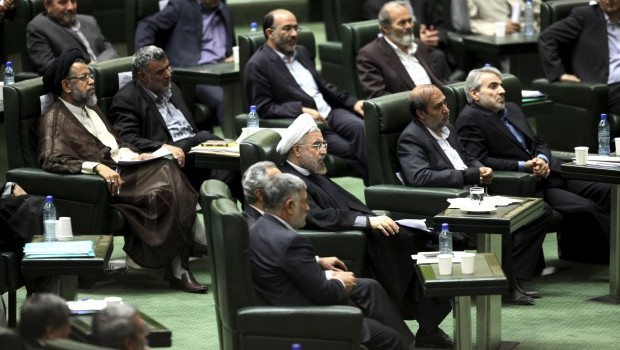Is Iran’s new president, Hassan Rouhani, boxing himself into a difficult situation? The question arises because Rouhani is telling Iranians he will ensure the sanctions are lifted without making concessions on the nuclear issue.
Rouhani faces a diplomatic Gordian knot.
On the one hand, he must prove that Iran is not trying to build a nuclear arsenal. But how does one prove a negative? Should he promise a total shutdown of Iran’s nuclear program which, if the Nuclear Non-Proliferation Treaty is the yardstick, appears perfectly legal? Ten years ago, he negotiated a suspension of uranium enrichment in a show of goodwill. Today, he cannot even do that, because uranium enrichment has been transformed into a symbol of Khomeinism’s fight against the American “Great Satan.”
Now, imagine that rubbing a magic wand produces agreement on Iran’s nuclear program. However, even then the lifting of sanctions would not be automatic.
Iran is subject to six different types of sanctions imposed since 1979.
The first set of sanctions is related to the seizure of the US Embassy in Tehran and the holding of its diplomats hostage. Under the Algiers Accord of 1980, a mechanism was to be created to lift those sanctions. That did not happen because the two signatories, Iran and the US, did not achieve the degree of mutual trust necessary. Things became even more complicated when Tehran used Hezbollah elements to kidnap and hold hostage dozens of Western citizens, including some 20 Americans, in Lebanon.
The second set of sanctions was related to the Iran–Iraq War and mainly aimed at stopping the two belligerents from obtaining military hardware. The war ended in 1988 when Iran accepted Resolution 598 of the UN Security Council.
However, the sanctions imposed remained in place. The reason is that Iran and Iraq failed to agree on a full implementation of the resolution’s provisions. Even today, the two neighbors have no mechanism for negotiating implementation.
The third set of sanctions was imposed by European nations in response to hostage-taking and terrorist activities in their respective territories. Between 1979 and 1993, a total of 127 Iranian dissidents were murdered in 11 European countries and Turkey. At the same time, terrorist operations linked to Iran claimed the lives of over 50 people in Spain, Italy, France, Belgium and Germany. In due course, the US joined some of the sanctions imposed by the Europeans.
Under President Mohammad Khatami, Iran’s terrorist operations in the West came to an end. However, most sanctions remained in place.
The fourth set of sanctions was imposed by the European Union in relation to sentences passed in 1992 on four Iranian officials by a criminal court in Berlin. The court applied for international arrest warrants against Supreme Leader Ali Khamenei, then-president Hashemi Rafsanjani, then-foreign minister Ali-Akbar Velayati and then-intelligence and security minister Ali Fallahian. This is why the four have not been able to travel outside Iran for a quarter of a century. Theoretically, those sanctions could be lifted only when the individuals accused of complicity in the murder of Iranian Kurdish dissidents in Berlin are brought to justice in Germany.
The fifth set of sanctions is related to Iran’s nuclear program. These are imposed on behalf of the international community through five unanimous resolutions of the UN Security Council. All UN members are required to impose those sanctions against Iran. Lifting those sanctions requires a new resolution abrogating the previous ones. Such a resolution could be tabled only when Iran has virtually shut down its nuclear program.
The sixth set of sanctions consists of those unilaterally imposed by the United States. These are built around the Iran and Libya Sanctions Act of 1996 passed through the US Congress by the Clinton Administration. In 2006, it was re-named Iran Sanctions Act after Libya agreed to US demands. Over time, the US has enforced a system of supposedly voluntary cooperation by non-US companies. This gives foreign firms a choice of doing business either with Iran or the United States. Those doing business with Iran are shut out of the American market and prevented from raising capital in the US. Not surprisingly, most companies choose the USD 16 trillion American market over the USD 1 trillion Iranian one.
Though imposing sanctions is easy, lifting them is often difficult.
Some of the restrictions imposed on Germany, Italy and Japan during the Second World War still remain in their constitutions, especially in relation to the manufacture and deployment of weapons. Although the Soviet Union collapsed two decades ago, some of the sanctions imposed on it, mostly related to dual-use technology and equipment, affected Russia for many years after the fall of the Berlin Wall. China is still subject to sanctions imposed in the 1950s. Many of the sanctions imposed on Iraq between 1988 and 2003 still remain in effect. Afghanistan’s Taleban was the subject of extensive sanctions imposed after it seized control of the country, many of which are still in place.
Imposing sanctions against a real or imagined enemy or adversary creates a mental block that is not easily removed. Once destroyed, trust between nations takes a long time to rebuild. Today, six decades after World War II, the US does not extend the same degree of trust to Germany that it does to Great Britain, for example. Even if Iran replaces the present regime, the sanctions imposed by the UN, EU and the US could take decades to lift. In fact, some may never be lifted.
